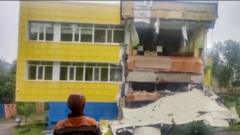In the wake of a powerful earthquake registered at 8.8 magnitude off the coast of Russia, tsunami warnings have spread across the Pacific Ocean, instigating emergency evacuations in areas ranging from Russia's far-east to northern Japan, Hawaii, and the U.S. West Coast. The quake struck near the Kamchatka Peninsula at approximately 11:25 local time Wednesday (23:00 GMT on Tuesday), making it among the top ten strongest earthquakes ever documented by the US Geological Survey. Fortunately, there have been minimal initial reports of severe damage or injuries.
In a significant response, thousands of individuals evacuated from various Pacific nations to safer, elevated locations; however, many tsunami warnings have since been reassessed and reduced in severity. In the United States, coastal cities experienced rolling waves, with Crescent City in northern California recording heights of 1.09m (3.6ft). Further south, tidal surges reached up to 0.7m in San Francisco, while Port San Luis experienced a notable surge described as "rapid and damaging."
Hawaii witnessed substantial evacuations as coastal residents sought refuge from incoming waves of around 1.2m (4ft) in Oahu and up to 1.7m on Maui. Governor Josh Green emphasized the dangers of tsunamis, warning that they could be lethal. However, reassurance followed as he stated that no significant wave impact had been observed hours after the event.
In Russia, tsunami waves reaching 5m (16ft) affected areas such as Severo-Kurilsk. Initial assessments showed no major injuries, and officials later lifted tsunami warnings for the Kamchatka region. Despite damage to power grids and several buildings, including a nursery, Governor Vladimir Solodov remarked that this earthquake was unprecedented for the region in decades, with at least six notable aftershocks following.
Japan's coastline felt the quake's effects as tsunami sirens woke thousands, prompting approximately two million residents to evacuate, particularly in Iwate Prefecture. Fortunately, warnings have subsequently been downgraded to advisory status in many regions, from Tokyo southward to Wakayama. Prime Minister Shigeru Ishiba confirmed that thus far, no damage had been reported. In a precautionary measure, evacuations at the Fukushima nuclear plant were carried out, though operators indicated that there were no abnormalities.
British Columbia in Canada has issued their own tsunami advisory for most coastal areas, advising residents to steer clear of the oceans until further notice. Meanwhile, alerts for Nuku Hiva in French Polynesia are predicting waves up to 4m and advisories remain active across regions including Papua New Guinea and Vanuatu. In China, alerts have been lifted, and the Philippines has rescinded theirs, although Taiwan's advisory remains active.
In various locations including Chile, Costa Rica, and Tonga, smaller tsunami wave actions between 1m-3m may still occur. In Peru, officials have enacted their own tsunami warning and continue to monitor the situation closely as the Pacific region remains vigilant in the aftermath of this monumental seismic event.
In a significant response, thousands of individuals evacuated from various Pacific nations to safer, elevated locations; however, many tsunami warnings have since been reassessed and reduced in severity. In the United States, coastal cities experienced rolling waves, with Crescent City in northern California recording heights of 1.09m (3.6ft). Further south, tidal surges reached up to 0.7m in San Francisco, while Port San Luis experienced a notable surge described as "rapid and damaging."
Hawaii witnessed substantial evacuations as coastal residents sought refuge from incoming waves of around 1.2m (4ft) in Oahu and up to 1.7m on Maui. Governor Josh Green emphasized the dangers of tsunamis, warning that they could be lethal. However, reassurance followed as he stated that no significant wave impact had been observed hours after the event.
In Russia, tsunami waves reaching 5m (16ft) affected areas such as Severo-Kurilsk. Initial assessments showed no major injuries, and officials later lifted tsunami warnings for the Kamchatka region. Despite damage to power grids and several buildings, including a nursery, Governor Vladimir Solodov remarked that this earthquake was unprecedented for the region in decades, with at least six notable aftershocks following.
Japan's coastline felt the quake's effects as tsunami sirens woke thousands, prompting approximately two million residents to evacuate, particularly in Iwate Prefecture. Fortunately, warnings have subsequently been downgraded to advisory status in many regions, from Tokyo southward to Wakayama. Prime Minister Shigeru Ishiba confirmed that thus far, no damage had been reported. In a precautionary measure, evacuations at the Fukushima nuclear plant were carried out, though operators indicated that there were no abnormalities.
British Columbia in Canada has issued their own tsunami advisory for most coastal areas, advising residents to steer clear of the oceans until further notice. Meanwhile, alerts for Nuku Hiva in French Polynesia are predicting waves up to 4m and advisories remain active across regions including Papua New Guinea and Vanuatu. In China, alerts have been lifted, and the Philippines has rescinded theirs, although Taiwan's advisory remains active.
In various locations including Chile, Costa Rica, and Tonga, smaller tsunami wave actions between 1m-3m may still occur. In Peru, officials have enacted their own tsunami warning and continue to monitor the situation closely as the Pacific region remains vigilant in the aftermath of this monumental seismic event.




















